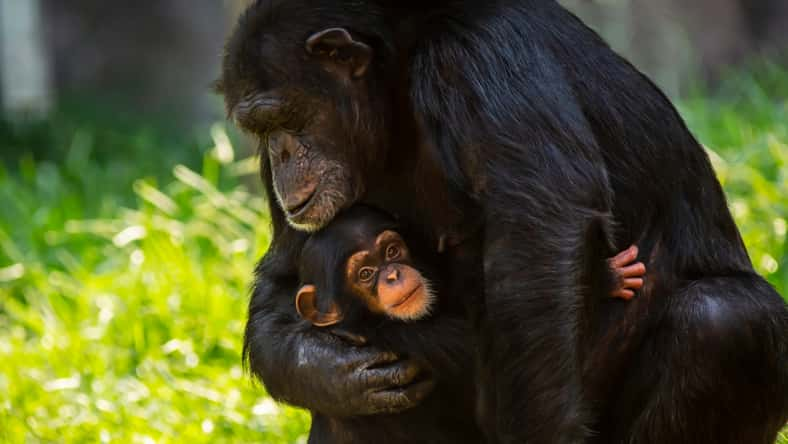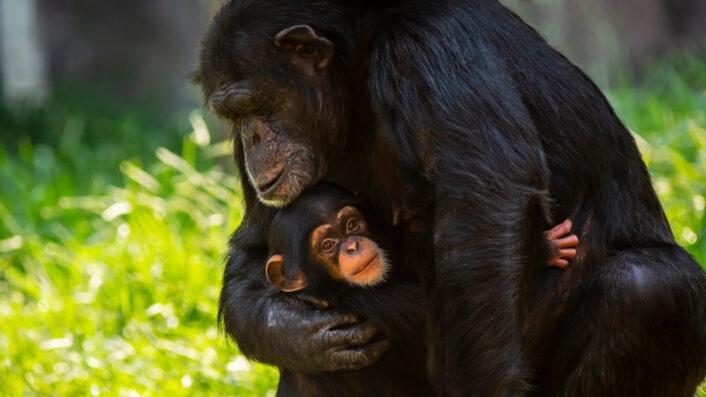Researchers Discovered That Chimpanzees Have Their Own Language That Uses Specific Sounds Tied To Specific Meanings

Humans are able to communicate danger by using words, sounds, and other expressions. For instance, if an object is about to fall, you could shout, “Oh no!” and gesture for someone to come over and help you.
Likewise, if you are walking with a friend and think they might be in danger, you could yell, “Watch out!” and wave your hands to get their attention.
These remarks, concerned expressions, and gestures are usually more than able to alert other humans of a potential threat.
But researchers from the University of Zurich wondered if some of our closest living relatives– chimpanzees– were also capable of this kind of communication.
So, in a recent study, the scientists got inventive and used fake snakes to simulate potential danger. The team strung the fake snakes on a fishing line; then, they watched and recorded how wild chimpanzees in Uganda reacted.
Afterward, the team also played back the elicited sounds in varying orders to determine if any of them caused a stronger response.
The researchers found that the wild chimpanzees did have specific sounds that corresponded with specific meanings.
On top of that, the chimpanzees were able to understand word order– or syntax– and react appropriately depending on what sound was elicited first in a sequence.
It was determined that the chimps made two distinct noises after spotting the snakes and other threats in the wild.

Patrick Rolands – stock.adobe.com – illustrative purposes only, not the actual chimpanzees
One sound, “alarm-huus,” was used as a call to alert for potential dangers. The second sound, “waa-barks,” called for other chimpanzees to help. So, when the researchers conducted their sound playback test, they reeled the fake snakes through the jungle while playing recordings of “alarm-huus” and “waa-barks” in different patterns.
Sometimes, the sounds were played alone; other times, they were put together in different sequences. The team found that chimpanzees elicited a stronger reaction when “waa-bark” came first, followed by “alarm-huus.” This suggests that sound order did impact chimps’ response to danger and pushed the researchers to conclude that syntax does exist in chimpanzees’ primitive language.
“We propose the ‘alarm-huu + waa-bark’ represents a compositional syntactic-like structure, where the meaning of the call combination is derived from the meaning of its parts,” the researchers concluded.
And this discovery does not just help scientists better understand chimpanzees but also the evolutionary history of humans.
According to the research team, the fact that chimpanzees use syntax shows that this did not start with human beings.
“But that the cognitive building blocks facilitating syntax may have been present in our last common ancestor with chimpanzees,” they explained.
“Humans and chimpanzees last shared a common ancestor approximately 6 million years ago. Our data, therefore, indicate that the capacity combines meaningful vocalizations is potentially at least 6 million years old,” said Simon Townsend, one of the study’s authors.
To read the study’s complete findings, which have since been published in Nature Communications, visit the link here.
If true crime defines your free time, this is for you: join Chip Chick’s True Crime Tribe
She’s Called The First Lady Of Physics, And She Was Invited To Work On The Manhattan Project
Here’s How You Can Resurrect A Houseplant That You Think Might Be On The Way Out
She Calls This Recipe Boat Dip, And It’s A Great Appetizer If You’re Planning A Day Out On The Water
Sign up for Chip Chick’s newsletter and get stories like this delivered to your inbox.
More About:Science





